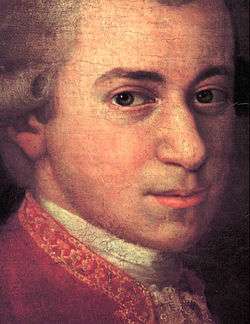Symphony No. 37 (Mozart)
The so-called Symphony No. 37 in G major, K. 444/425a, is an introduction by Wolfgang Amadeus Mozart to a symphony in G by Michael Haydn.
History
The complete symphony was for a long time believed to be a work by Mozart, but is now known to have actually been mostly written by Michael Haydn, being his Symphony No. 25 in G major, Perger 16, Sherman 25, MH 334. The true authorship was discovered by Lothar Perger in 1907. Modern commentators find it "difficult to comprehend how the editors of the Breitkopf edition of Mozart could have considered the three movements of the G major Symphony as the immediate successor of the 'Linz' Symphony; the infinitely simpler and more archaic art of the Salzburg master offers such a contrast that one might well suppose this symphony to date much earlier than 1783" if Mozart had been the one to write it.[1]
The introduction was probably composed in late 1783 to be performed in the same concert in Linz, in which Mozart's Symphony No. 36 received its premiere.[2]
Mozart probably copied out the score in order to learn from it, but he wrote a new Adagio maestoso introduction for it (few of Michael Haydn's symphonies have slow introductions). Mozart's introduction in triple time ends with a fermata on a V7 chord, which leads into a tonic chord beginning Haydn's work. Saint-Foix considers the introduction "an expressive prelude, which, moreover, is by no means entirely in key with the movement it is intended to prepare."[3]
Mozart did not copy the rest of the work verbatim: he removed a bassoon solo from the middle Andante sostenuto movement, and "appears to have reduced the colla parte writing in the winds throughout the work," according to Gary Smith.[4]
The numbers for Mozart's Symphonies Nos. 38 through 41 have not been adjusted because of this symphony.
According to the Breitkopf & Härtel edition, the score calls for flute, 2 oboes, 2 horns and strings; performances tend to include bassoons (always in unison with the celli except for significant passages in the adagio), which were part of Michael Haydn's original score but left out by Mozart, and a harpsichord playing figured bass based on the cello line. The flute is only used for the first section of the slow movement.[5]
References
- ↑ Saint-Foix, Georges de. The Symphonies of Mozart, transl. Leslie Orrey. London: Dennis Dobson Ltd. (1949): 94
- ↑ Leopold, Silke (ed.): Mozart-Handbuch. Kassel: Bärenreiter 2005, ISBN 3-7618-2021-6, p. 307
- ↑ Saint-Foix, Georges de. The Symphonies of Mozart, transl. Leslie Orrey. London: Dennis Dobson Ltd. (1949): 95
- ↑ Smith, Gary. "Haydn, Michael (1737–1806)". mozartforum.com. Retrieved 6 October 2007.
- ↑ Pajot, Dennis. "K444 Symphony #37". mozartforum.com. Retrieved 2009-07-17.
Sources
- Perger, Lothar (1907). Thematisches Verzeichnis der Instrumentalwerke von Michael Haydn. Vienna: Artaria.
External links
- Symphony No. 37: Scores at the International Music Score Library Project
- The Classical Archives have Mozart's introduction in a separate file in the Mozart page.
